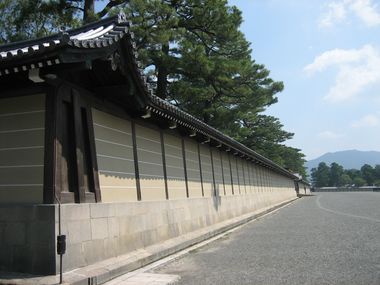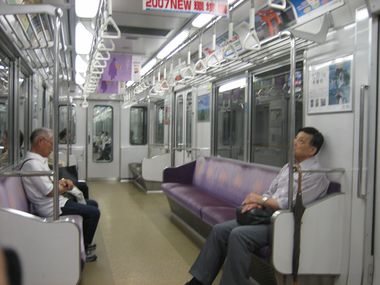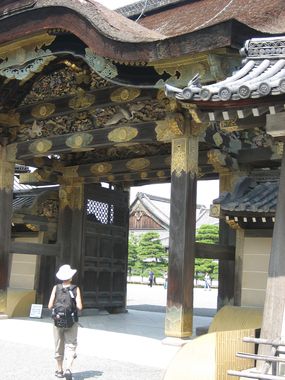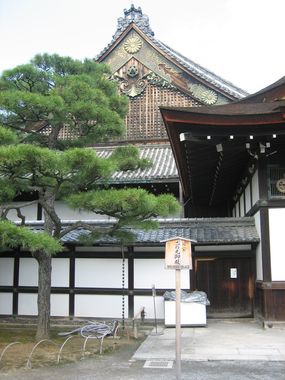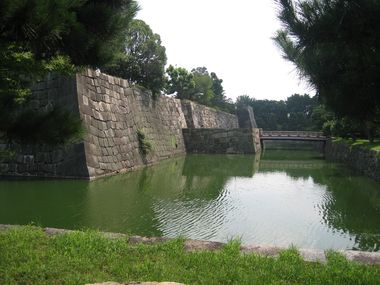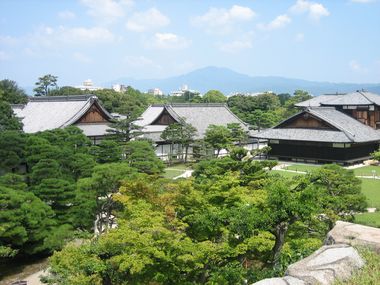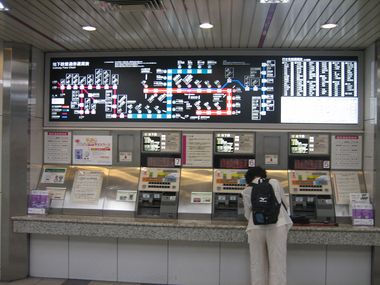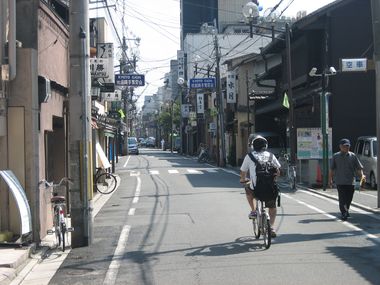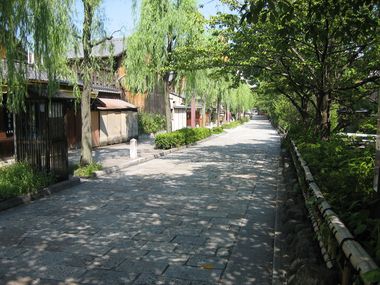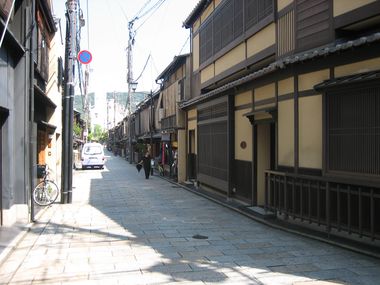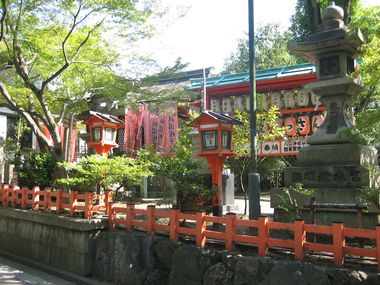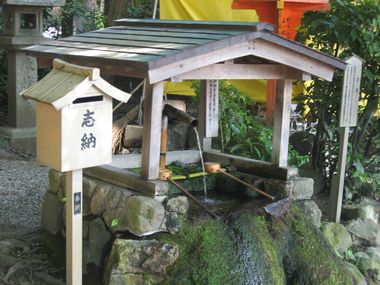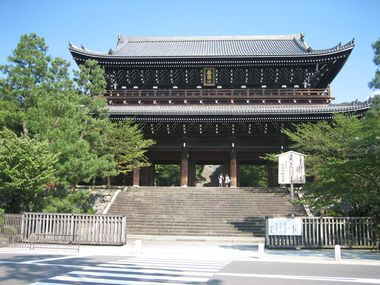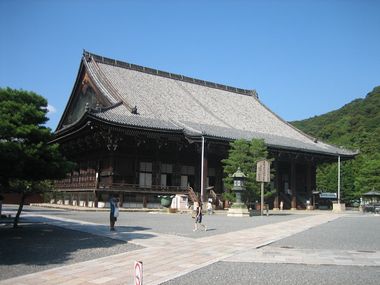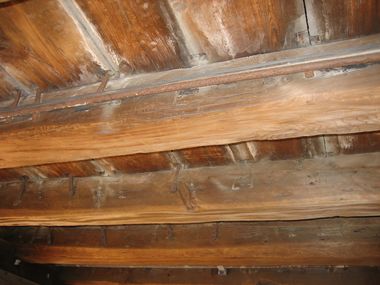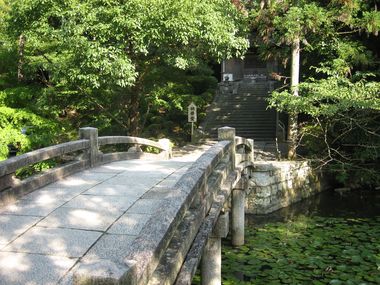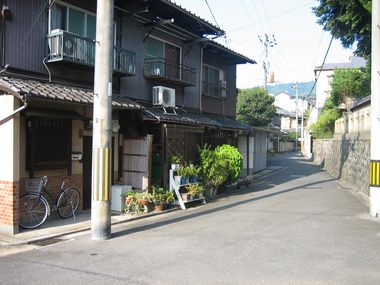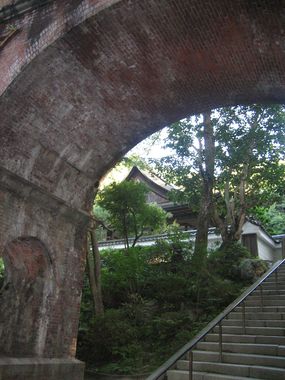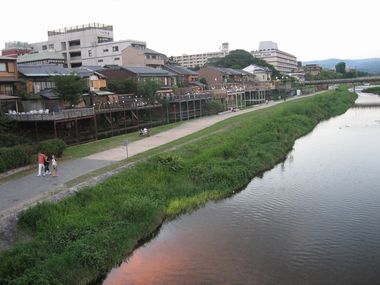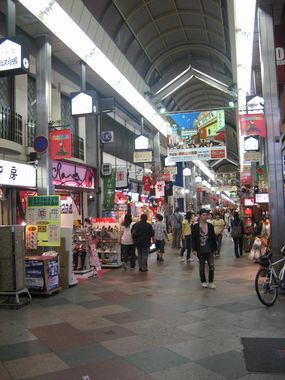Day 11 - Kyoto Day 1
Tuesday, September 4th, 2007
Kyoto is really quite interesting, much more so than Yokohama. So much to see and do. Getting around is a bit difficult as the distances are quite large but we have seen a number of bicycles, which has to be the transportation of choice.
I knew before we got here that visiting the Kyoto Imperial Palace may be difficult. You have to apply in person with your passport or months ahead of time on the Internet before you will be able to have a tour. Knowing this (and crossing my fingers) we headed north from our hotel which is just south of the grounds of the Kyoto Imperial Palace (which is surrounded by the Kyoto Gyoen National Garden – basically, a large public park) to see what we could do about getting tickets not for today but for Thursday as our hope for getting in today was pretty much non-existent. Not having had breakfast our trip to the palace was interrupted as we looked around for a place to eat. I don't think anyone in this country actually eats breakfast outside of their homes which leaves us in a bit of a spot (the hotel normally offers breakfast but the chef is away this week). Wandering in the heat and humidity I was getting a bit touchy as was my mother so eventually we threw in the towel and, I hate to say it, we had something to eat at a McDonalds. Say what you like: They had food, drink, and it was air-conditioned. Three things we did not have. No, the menu was not any different than anywhere else in the world. They might have had a special burger for Japan but honestly I did not pay much attention to it.
From the restaurant we entered into the National Garden grounds which are quite pleasant. Basically a lot of trees and wide gravel paths. Mother was fascinated with the clear areas in the gravel where people cut through the park on their bikes. Straight as an arrow. Continuing through the park it was not too difficult to spot the palace as it is a very large rectangular shaped building in the middle. The 20 foot walls have gates in regular intervals with fantastic thatching on their roofs and impressive large wood doors. Most of the gates are, of course, closed except for the main entrance for tours to the west. The wall is also surrounded by a small drainage ditch which we walked along to keep out of the sun heading to a small administration building a small distance from the palace. We were relieved to find out that it would not be a problem to get a tour for Thursday (or even today if we had wanted) so we filled out the application and received a ticket to present when we return. Fantastic!
The Kyoto Imperial Palace (Kyoto Gosho) is (was) the official palace of the Japanese emperor (who now lives for the most part in the palace in Tokyo) keeping in mind that since the end of World War II, as part of the peace treaty, the emperor is no longer the head of state but just a figurehead.
Walking through the northern end of the grounds we took the subway to Nijo-jo-mae Station which is just across the street from Nijo Castle (“mae” means beside). The castle was built as the local residence of the Tokugawa Shoguns in 1626. It is quite different than anything we have seen in Tokyo or Yokohama – A real bit of Japanese history. The castle is surrounded by large walls and a moat. We passed by a number of coaches parked at the front gate and entered across a bridge. Inside the walls there is another wall housing the residential area itself. Entering into this area through a fantastic gate the Ninomaru Palace is directly in front of you.
We entered the palace for a look around. Taking our shoes off and leaving them where we were directed we walked along the floors about six feet off of the ground. The wood floors are what is known as “Uguisu-Bari” or “Nightingale Floors” which squeak when you walk on them – no matter how lightly you tread. This was a security mechanism meant so that no one could sneak up on the residents. As a tourist you are able to walk on a route all around the palace (squeak, squeak, squeak…) looking into each of the large tatami-mat lined rooms. The rooms where the Shogun would meet people he would sit on a raised section of the floor with a set of sliding doors in the wall that hid his personal bodyguards who could come to his aid quickly if it was required. The paintings on the walls and doors are absolutely amazing even after so many years – Painted cranes, other wildlife, and scenery are quite incredible – True Japanese understated simplicity of design.
Leaving the Ninomaru Palace there is another palace, the Honmaru or Inner Palace separated from the rest of the castle grounds by another moat and more high buildings.
The gardens all around the castle are very good examples of Japanese garden design with lovely pools and rocks. We even spotted a heron in one of them! Obviously, the obligatory goldfish (Koy) as well in the water. The trees, lawns and other plants are meticulously maintained.
Climbing to the top of the “Dungeon” at a far corner of the Honmaru Palace wall we were able to look out over the castle complex seeing the city beyond the walls and the mountains surrounding the city. Did I not mention that before? Oh yes, Kyoto is basically flat but on all sides it is surrounding by mountains (well, low mountains but mountains nonetheless).
We continued around the outside of the palaces and through the gardens back to where we entered stopping only briefly for a cold drink cup of Coke with ice (from a machine) then in the souvenir/snack building near the entrance. Mother spent quite a few minutes looking through the souvenirs while I tried a local soft drink that is in an interesting bottle: To drink it you snap off the top of the (glass) bottle and a ball attached to the bit you snapped off drops into the bottle (down to a crimp in the neck) then you drink. Not a remarkably tasty drink but cool and sweet. Mother indicates that she remembers seeing this type of bottle in Canada when she was a child. She helped herself to a Kirin Lemon (which was a bit tastier).
Kyoto is well known for it's hundreds of temples and shrines. Even just walking down the street we passed quite a few of them – often nestled in just a small gap between buildings but more often full-blown temples between the modern buildings on either side. A Japanese philosopher used to regularly walk along a path passing by a number of temples on the side of the eastern wall of mountains. To this day the path is known as the Philosopher's Walk and we knew that we had to give it a visit.
Taking the subway once again we got off at Sanjo Keihan station and headed south along the (Kamo) river to Gion passing through an interesting set of restaurants and shops surrounding a modern Japanese garden.
The Gion area of Kyoto is where traditionally the geisha lived and did business. They still do. As we walked along the narrow stone-cobbled road lined with wood houses and wooden utility poles we were able to look into small shops selling exquisite kimonos, art, antiques, and even wigs. Looking down side streets we saw residences with geisha walking around and people just ignoring them – Just part of the scenery here! The area is actually very pretty and quiet.
Arriving at a large road we saw that the pavement (sidewalk) was covered much like what we had seen last night when searching for something to eat. On the north side of the street the shops are very fancy but we quickly passed over to the south side of the street where the shops were a bit less expensive and more interesting…One was selling only different kinds of pickles. Hundreds of different kinds of pickled vegetables and fruits. They had samples. Delicious. We also dropped into a small temple. I was also able to try more “Takoyaki” (small size in this case) from a stall beside the road (he was running out so I only had a half-size portion). Hey, eat whatever looks interesting!
At the end of the road sits the Yasaka Shrine which is currently undergoing some construction as the magnificent front gate is covered in plastic and scaffolding. We entered anyway and walking up a stone path we were overwhelmed with the peace of place. It is so colourful and beautiful. Red fences line the stone path, wonderful carvings of lions, and, of course, the buildings. These are the buildings you typically think of when you think Japanese: A normal pitched roof but with the corners angled back up – Very elegant. Many of the roofs here in the temples are actually thatched as well which I think is quite pretty. It is amazing how the simple is just so elegant – The water that you wash your hands with comes from a fountain that is flowing over a rock while you pour water over your hands using these simple wooden spoons. Wow.
Heading to the north from Yasaka we visited the Chion-in Temple (evidently of the Pure Land Sect form of Buddhism) which sits at the top of a LOT of stairs up from the street. Passing through the impressive gate there is a long series of steep steps to the top – Not very good in this heat. The temple is worth it though as the main building is huge and quite impressive.
We took off our shoes and sat along the back wall of the main temple building to watch people coming in to worship. An attraction for people walking around the elevated walkway that encircles the building is to spot the umbrella that a construction worker dropped into the wire pigeon mesh under the eaves. Sigh. More nightingale floors here as well…squeak, squeak, squeak…
Walking down a small side road we passed by some schools and houses as we made our way to the next temple. We had to walk on the road itself as the way is so narrow. The Shoren-in Temple is just off of the road but we did not visit as they were asking an entrance fee and we were interested in the walk. Continuing along we took a side street marked on the map that eventually petered out to nothing. There were some cars parked outside of houses where they had actually run into the house as the space was so tight! Small houses and very peaceful back here.
Along the way we passed by another temple that is not on the map but looked very utilitarian. That is something to note about all of these temples – They all look well used with people always around using them and with the grounds so well maintained. Tourists are generally in the minority of the visitors!
Anyway, we were not yet at even the beginning of the Philosopher's Walk, so, soldiering on we came to a big road (we have been trying to avoid big roads) and passed by the local Westin hotel (very impressive place looming over the street below as it backs onto a mountain). We were getting a bit lost at this point (following the local tourist map) but I spotted where we needed to go – A small pedestrian/bicycle tunnel (probably formerly a road) leading to a small road past the next temple on our tour – The Konchi-In temple which we did not visit (another admission charge) but did have a quick look from the street – A small temple with a lovely gravel garden all around behind the surrounding wall. At the end of the road we turned to the right – According to the map we were finally on the Philosopher's Walk! We continued down to the Nanzenji Temple which had another wonderful front gate. Heading towards the main temple buildings up the side of the hill we were surprised to come across an impressive large brick aqueduct taking water down from the mountain to the city below (I am not sure if the water is still used…).
Walking under the aqueduct we were able to climb up through some of the temple buildings and the side of the mountain. Quite peaceful wandering around exploring the various corners of the site. At the one end of the aqueduct we walked into a small temple building with a lovely small garden in the courtyard – No visitors up here yet still very much open to our visiting.
It was beginning to get dark so we did wander to the Eikando Temple but only paid a passing visit. Now we had to figure out how to get back to the centre of the city. The problem with the Philosopher's Walk for us is that any subway station is actually quite a ways away from the walk itself. In this case we decided to walk right back to the city centre. We have been walking all day so had a short sit beside a small pond with a fountain in the middle. This is the area around the Kyoto Municipal Zoo with the art museum next door.
Wandering down the big road we eventually ran out of road. It turned into a small alley but lead in the direction we wanted so we continued down the alley which turned out to be a great way to see the area as we saw many people just going about their lives as they return home for the evening. Eventually we found a bridge across the river and returned to the street we had visited last night for sushi, indeed, we even ate just around the corner at a small local place. The food was cheap and not too bad but disappointing.
We took our time heading back to the hotel as we visited a street completely covered (not just the sidewalk/pavement but the whole road!) and wandered around through some more souvenir shops. Still looking for some good T-shirts with Japanese (not English) on them – Difficult to find, believe me. Kyoto has all the trappings of a big city including 24 hour Internet cafes and (more) 7-11s (no, no Slurpees!).
Further Information
For further information, please see:
- Welcome to Kyoto - Official web site for KYOTO Prefectural Government Tourism and Convention Office
